health benefits of sesame seed
- Sesame seed helps reduce Cholesterol: Provides healthy fats and antioxidants such as Vitamin E
- Strengthens Bones: Due to its mineral content like calcium and magnesium
- For Skin care: The healthy fats and antioxidants helps keep the skin smooth and young
- Boosts Metabolism: It has protein that boosts metabolism. One of the compounds of sesame seeds, sesimol, is known to protect DNA from the harmful radiations of chemotherapy.
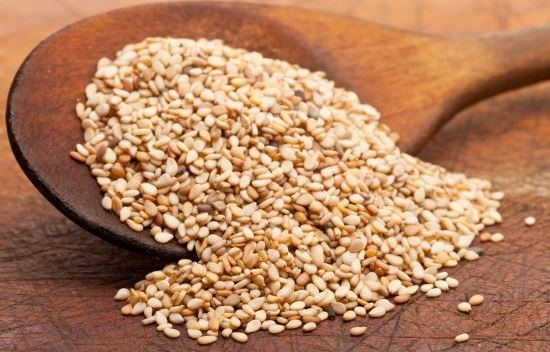
KEYWORDS FOR SESAME SEED FOR YOUR WEBSITE
#sesameseedinnigeria #sesameseedproductioninnigeria #sesameseedexportinnigeria #hulledsesameseedinnigeria #naturalsesameseed #sesameseedcultivationinnigeria #growingsesameseedinnigeria #nigeriansesameseed #sesameseedoil #sesameseedoilinnigeria #sesameseedprice #sesameseedseason #sesameseedpriceinnigeria #sesameseedseasoninnigeria #sesameseedfarming #sesameseedfarminginnigeria
Sesame
Description and Cultivation
Sesame seed is believed to be one of the oldest seeds to have been used as a condiment, as well as for the home-based production of oil. Sesame oil is a traditional cooking oil with a long history, which is mainly cultivated in India and china but also in Sudan and neighboring countries and in parts of Central America (e.g. Mexico).
It is derived from the seeds of the sesame plant which is mainly cultivated in tropical and sub-tropical areas with a dry and a rainy season. It requires a lot of water in order to grow and ripen and a dry season during the harvesting. It is an annual plant, growing on average between 50cm to 250 cm high and is rich in flowers.
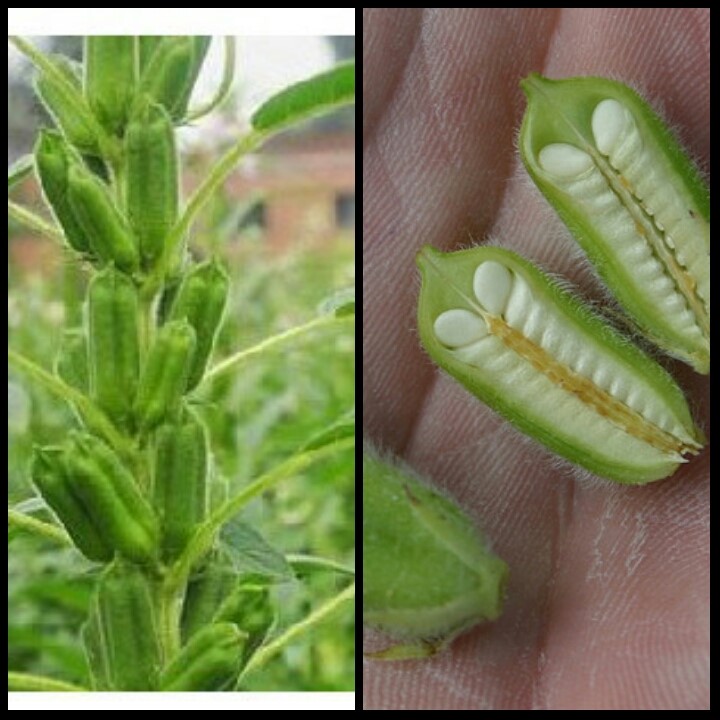
Ideal growing temperatures lie between 27 and 30oC. Harvesting is done by hand, with the plants being cut manually and dried in the field. They are then shaken so that the seeds fall out of the open pods. The harvesting period in the Northern Hemisphere is between October and December and, in the Southern Hemisphere, March. The largest producers in Asia are China and India; in Africa it is Sudan followed by Nigeria while, in Central America, it is Mexico and Guatemala.
Sesame seed is used mainly for human consumption on bread, bread sticks, cookies, health snacks (such as sesame bars), in prepared breakfasts (as an additive to cereal mixes) or on breakfast crackers.
Sesame oil
Sesame oil has an unsaponifiable fraction with a unique composition. Sesamolin and sesamin may be found in concentrations up to 1 - 1.5 %. They are reported to give a high oxidation stability, especially at elevated temperatures. Concentrates of these or straight sesame oil have been used as an additive to increase the oxidation stability in frying oils.

Sesame oil is also mainly used for human consumption but a small percentage is used in the soap, cosmetic and skin care industries. The market for sesame oil is mainly located in Asia and the Middle East where the use of domestically produced sesame oil has been a tradition for centuries.
Oriental sesame oil has a dark colour and characteristic, nutty odour, which is developed by roasting the seeds before extracting the oil.
SESAME SEED IN GREECE
Sesame seeds have been a common food ingredient in Greece since ancient times, and are still an essential part of Greek cuisine. Greece sources most of its sesame seed supplies from developing countries and it is the largest European importer of sesame seeds.
Greece buys both hulled and natural sesame seeds, providing opportunities for suppliers without value addition facilities. Nonetheless, the current political and economic scenario has increased the counterparty risk in Greece extensively, requiring precaution in finding the right buyer and doing business.
PRODUCT DEFINITION
Sesame seeds (Sesamum indicum) are grown primarily for their oil content. In Europe, sesame seeds are primarily used for toppings on bakery products e.g. bread, bagels, hamburger buns) and confectionery. Restaurants and natural food consumers purchase sesame seeds for use in ethnic dishes. Sesame seeds can also be used in snacks and crackers, often in the form of "sesame sticks". Sesame seeds are supplied by countries in Africa, Latin America and South Asia.

PRODUCT SPECIFICATION
Quality
General:
- There are different types and qualities of sesame seeds.
- White seeds are a white-to-golden colour and receive a higher market price than mixed seeds, which range from yellow to dark brown. White seeds are used primarily in natural or hulled form because of their aesthetic value, whereas mixed seeds are generally crushed into oil.

- Make sure that the sesame seeds are fresh and that there are no long delays between harvesting and transportation. Sesame seeds should also be free from sand, stalk, plant debris and other foreign materials.
- Some of the most important quality factors concerning sesame seeds are: odour, flavour, oil content, moisture content, colour, size, uniformity of seeds, purity and damaged/mouldy seeds. Sesame seeds should also be free from mycotoxins and harmful microbiological activity. Aflatoxin and Salmonella contamination are known to be a problem for many producers, and buyers closely monitor these aspects.
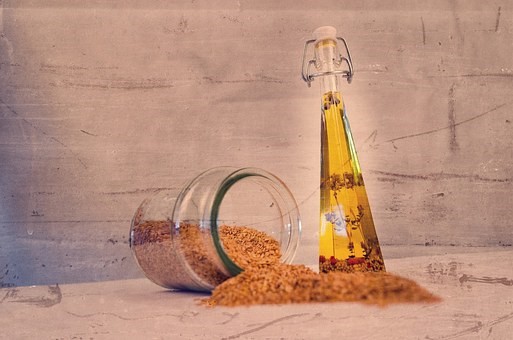
DARKER SEED PREFERABLY USED TO MAKE OIL
- The minimum quality requirements for sesame seeds will depend greatly on the end-product the seed will be used for, e.g. tahini needs a sweet taste and aroma (some origins are not suitable), bakery purposes (high purity levels required), sesame oil (clarity is important); the use of either natural or hulled sesame seeds will also depend on the end-product.

TAHINI PASTE
- Prevent contamination by keeping facilities and equipment clean.
- Ensure proper storage and transportation (see 'Packaging').
Organic (if relevant)
- Comply with organic standards for the production of sesame seeds. Refer to the section on 'Niche requirements' for further details on organic production and labeling.
Labeling
- Ensure traceability of individual batches.
- Use the English language for labeling unless your buyer has indicated otherwise.
- Labels must include the following:
- Product name
- Manufacturer' lot or batch code
- If the product is destined for use in food products
- Name and address of exporter
- Product's country of origin
- Shelf life: best before date/ use by date
- Net weight/volume in metric units
Packaging
- Sesame seeds for the European market are transported in containers in paper sacks, bags of woven natural materials (e.g. jute) or woven plastic polypropylene / polyethylene (PP/PE) bags. Buyers may have specific additional packaging requirements.
- They are usually shipped in containers with a capacity of between 16 and 19 tonnes, and in 25kg or 50kg bags.

- Organic sesame seeds should remain physically separated from conventional sesame seeds.
- Ensure preservation of quality by:
- Thoroughly cleaning and fumigating the holds or containers before loading the seeds.
- Protecting the cargo from moisture during loading so as to avoid mould, spoilage and self-heating.
- Ensuring appropriate temperature, humidity/moisture and ventilation conditions during transportation.
- Protecting the cargo from pests such as beetles, moths, etc.
Trade and Macro-economic statistics of Sesame seed in Greece
IMPORTS
Figure 1: Total imports of sesame seeds to Greece, in 1,000 tonnes.
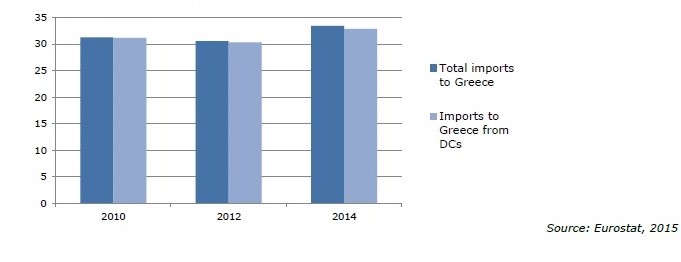
- In 2014, the total amount of sesame seeds imported into Europe amounted to 153,000 tonnes and around 306 million.
- Greece is the largest importer of sesame seeds in Europe (22% share in volume), accounting for 33,000 tonnes/60 million in 2014. This is due to the popularity of sesame seeds as an ingredient in traditional Greek cuisine. The oilseed is in particular used as an ingredient for spreads such as tahini and halva, as well as in bakery and confectionery products.
- Almost all Greek imports of sesame seeds (98%) originate directly from developing countries.
- Between 2010 and 2014, Greece reached an average annual increase in volume of +1.7% and +13% in value between 2010 and 2014. This indicates that imports of sesame seeds still showed an upward trend despite the economic crisis, but recorded an annual growth rate below the European Union's average (+2.9%).
Figure 2: Imports of sesame seeds to Greece; the largest markets (in terms of 2014 volume) exporting sesame seeds to Greece, 2010-2014 in 1,000 tonnes
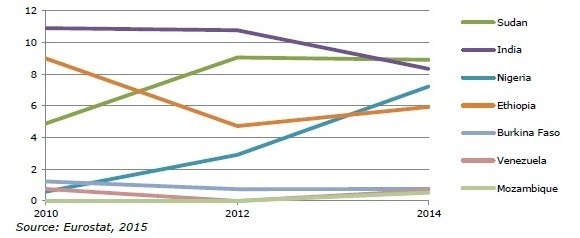
- The largest developing country suppliers of sesame seeds to Greece are Sudan (27%), India (25%), Nigeria (22%) and Ethiopia (18%).
- In 2014, Indian supplies of sesame seeds to Greece amounted to around 8,300 tonnes (16 million). These supplies mainly consist of hulled sesame seeds, which explains the high value. Indian imports have recorded an annual -6.5% decrease in volume and -6.2% in value since 2010. India experienced a weak sesame harvest due to heavy rainfall in different sesame-producing areas of the country, which affected its supplies in 2011, 2012 and 2013 (Business Standard, 2013).
- In this respect, Sudan took over the position as the largest supplier of sesame seeds to Greece. Between 2010 and 2014, Sudan had an annual average increase of +16% in volume and +30% in value, reaching 9,000 tonnes of total Greek imports in 2014 (27% share of volume).
- Another large supplier of sesame seeds to Greece is Nigeria, whose supplies in the period 2010-2014 increased from 577 tonnes to 7,300 tonnes, which signified an annual increase of +88% in volume and +100% in value.
- Ethiopia's supplies experienced a decline between 2010 and 2014 due to contract default (i.e. contract fidelity was not respected), with an annual average decrease of -10% in volume and -1.4% in value. Nonetheless, Ethiopia's exports have shown signs of recovery in 2014, as confidence which was lost due to contract fidelity issues began to return
Exports
Figure 3: Exports of sesame seeds from Greece; the largest countries importing sesame seeds from Greece (in terms of 2014 volume), 2010-2014 in 1,000 tonnes.
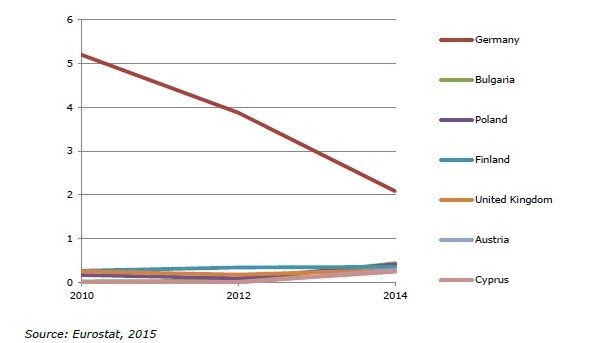
- Greece is the second largest exporter of sesame seeds in Europe. In 2014, it (re-)exported around 5,000 tonnes / 11 million of sesame seeds, having decreased in volume (-7.4% annually), but increased in value (+5.2%) since 2010.
- In 2014, Germany represented the main destination for Greek sesame seed exports. Germany received around 2,000 tonnes of sesame seeds, representing a share of 42% of total Greek sesame seed exports. However, a significant annual decline of sesame seed exports to Germany was recorded between 2010 and 2014 (-20% in volume and -10% in value). This indicates that Germany is importing sesame seeds directly from producing countries, rather than using Greek companies as intermediaries.
- Other important destinations of Greek sesame seed exports are Bulgaria (8.8% share in volume), Poland (8.3%), Finland (7.2%), the United States (5.7%) and Austria (5.6%).
Consumption
Figure 4: Apparent consumption1of sesame seeds in Greece, in 1,000 tonnes.

- Greece is the largest market for sesame seeds in Europe, accounting for nearly one quarter of the total market. Sesame seeds are commonly used as ingredients for food products in traditional Greek cuisine. Germany is also a large market in Europe, accounting for nearly another quarter of the total market.
- Apparent consumption in Greece has recorded average annual growth of +4.0% since 2010, amounting to 28,000 tonnes in 2014. Apparent consumption does not take into account sesame products which are imported into Greece from other European Union countries, thus real sesame consumption is higher than the reported figures.
- Although Greece produces sesame seeds in small volumes, the country is almost entirely dependent on imports. Almost all of these imports (98%) originate directly from developing countries.
MARKET TRENDS
Popularity of sesame in Greece and the economic crisis
- The consumption of sesame seed can be traced back to Ancient Greece, where it was used for its therapeutic effects, stimulating energy and athletic performance.
- Nowadays, sesame seed is mostly used as an ingredient for the production of traditional Greek food products, such as tahini (a paste of ground sesame seeds), pasteli (a pastry based on honey and sesame seeds), and halva (consists for 60% out of tahini), often used in Greek cooked dishes, spreads such as hummus and salad toppings.
- In Greece, the food and beverage industry has the highest percentage of enterprises (60%) among all manufacturing sectors; furthermore, it employs around a quarter of total employees engaged in manufacturing (SEVT). Considering enterprises with more than 10 people in the food and beverage industry, a share of over 30% is engaged in bakery products (Eurofound) - one of the most important sectors for sesame seeds.
- In spite of its importance to the Greek economy, as mentioned above, the country's food industry has seen a decline in the last few years, following the severe economic crisis which has hit the country (Greece in figures, 2014), thus affecting demand for various food ingredients.
- The effects of the crisis have been further exacerbated recently due to cash flow problems which are spread throughout the economy, with implications for food companies. At the retail level, the economy is estimated to have shrunk by nearly a quarter, led by austerity measures which restricted the population's purchasing power (Business Insider, 2015). As Food Navigator describes, much will depend on further developments of the Greek economy, including whether Greece leaves the Eurozone or not. With the increase in counterparty risk, doing business in Greece at the moment requires caution.
Salmonella risk in sesame seeds
- A multistate outbreak of Salmonella in the USA in 2011, caused by the consumption of tahini, raised awareness of the food safety related issues for sesame seed worldwide. One of the 'kill steps' of salmonella is the roasting of sesame seeds, which is not done during the traditional process of making tahini.
- In Greece, the homeland of tahini, safety concerns were expressed after salmonella contamination was detected on several occasions in the last years. In 2014, for instance, Greek customs officers found a container load of sesame seeds contaminated with Salmonella originating from India, rejecting it for import. In 2014, India was the second largest supplier of sesame seeds to Greece, behind Sudan. With high embedded use of sesame seeds in Greek traditional food products, salmonella represents an important risk for Greek importers, which means that suppliers of sesame to the Greek market can expect (increasingly) regular and strict controls.
Sesame seed allergy in Greece
- Sesame seed allergy is the most common type of seed allergy in Europe. Sesame seed is becoming increasingly reported as the trigger for IgE-mediated allergic reactions in all populations. Allergy to sesame seeds has been increasing in incidence in the Western world over the past five decades.
- Sesame seeds is included on European Union's list with most common food allergies (EC directive 89/2003). However, prevalence of allergies in children is recorded to be 1.7% in Greece, compared to the higher 4-5% in Italy, Spain, France, UK, Netherlands and Germany.
Market channels and segments
Trade channels for sesame seeds in Greece do not differ significantly from the general structure as described in CBI Market Channels and Segments for Oilseeds.
Figure 5: Trade channels for sesame seeds in Greece
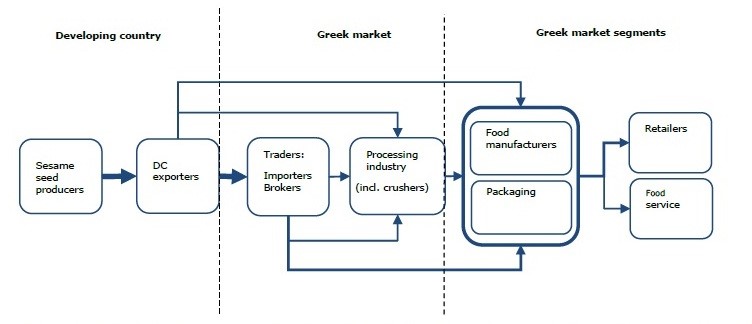
The Greek food market for sesame seed trade can be divided into two main segments, based on the end use of the seed:
- The crushing industry relates to the segment in which sesame seeds are crushed to produce sesame oil. FEDIOL figures indicate that sesame crushing activities in Greece are not significant.
- The edible seed industry can be divided into two:
- Food manufacturing: sesame seeds are an important ingredient for processing traditional products such as tahini, halva (confection made from sesame paste and a sweetening agent), which are also destined for export.
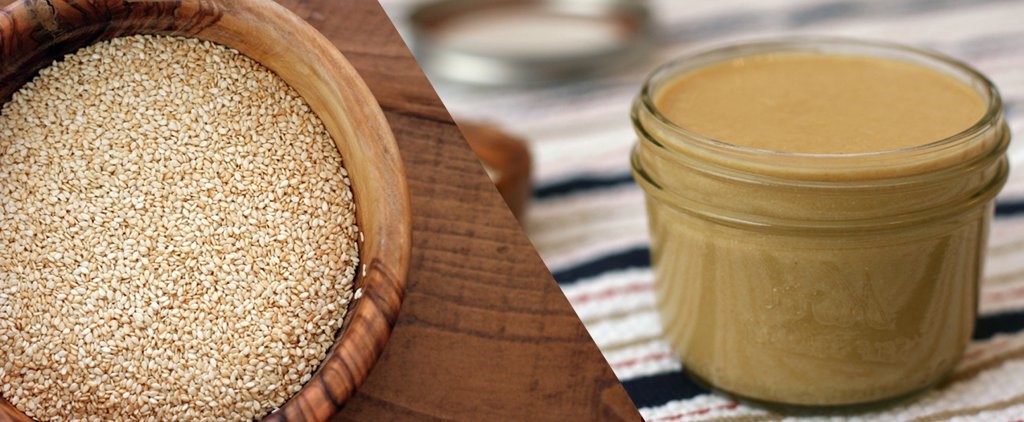
TAHINI
- Confectionery: sesame seeds are also used on the surface of tsoureki, breads and other bakery products to enrich their flavour and aroma.

In a global context, the Greek market is regarded as specialty, whereas the markets of Asia can be described as commodity. Sesame seeds are classified into three main grades, which also relate to the end-use of the seed as described above: 1) crushing grade; 2) food grade; 3) confectionery grade. Within these grades, sesame seeds can be further segmented into: non-certified high quality seeds and certified high quality seeds.

Price
- Price levels for sesame seeds from different origins show similar developments, thus indicating a price interdependency between the various global suppliers. In addition, the international market depends greatly on the annual volumes produced in both India and China. China produces large quantities of sesame seeds each year to meet the substantial domestic demand for sesame seeds. Any delay or failure in Chinese crops puts a constraint on the global availability of sesame seeds, which has an impact on price levels as well.
- Sesame prices have been volatile since 2009, but experienced a steady increase from the end of 2012 due to tightening supplies, reaching between US$2,000 and US$2,500 per tonne, depending on the origin and quality. Nonetheless, prices crashed through 2014 and early 2015, ranging between US$1,200 and US$1,500 on poor Chinese demand and good production levels worldwide.
SESAME SEED IN GERMANy
Introduction
Germany is a key market in Europe, being the largest importer of sesame seeds in the region. In Germany, sesame seeds are mainly used as ingredients in bakery products and snacks. Use in salads and ethnic cuisine is growing and the place of sesame seeds in vegetarian diets is also increasing. Opportunities can also be found in the organic sectors: the organic food market in Germany is growing strongly (+7% in 2013).
Trade and macro-economic statistics
Imports
Figure 1: Total imports of sesame seeds to Germany x 1,000 tonnes.

- In 2014, total European imports of sesame seeds amounted to 153,000 tonnes (306 million). Germany's share of those imports was around 22% in volume and in value.
- Germany does not produce sesame seeds, making the country entirely dependent on imports. Germany is the second largest importer of sesame seeds in Europe (after Greece), accounting for around 32,000 tonnes/67 million in 2014. Sesame seeds are commonly used in bakery products as an ingredient or as a garnish on the surface of breads.
- German imports of sesame seeds increased in terms of both volume (+1.5%) and value (+14%) between 2010 and 2014.
- Around 77% of sesame seed imports in 2014 originated directly from developing countries (DCs). More specifically, around 25,000 tonnes (51 million) of German sesame seed imports were sourced from developing countries.
- Germany's direct imports from developing countries have increased substantially over the past five years, recording average annual growth of +8.6% in volume and +21% in value.
Figure 2: Imports of sesame seeds to Germany: the largest markets (in terms of 2014 volume) exporting sesame seeds to Germany, 2010-2014 in 1,000 tonnes
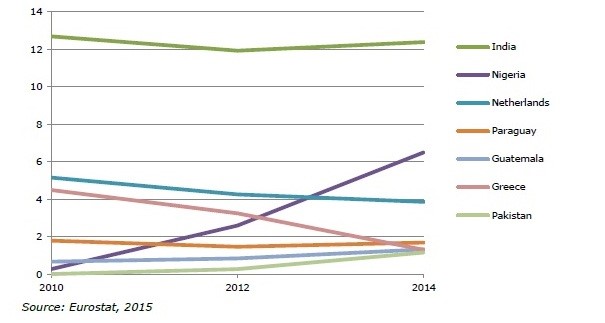
- The most significant developing country suppliers of sesame seeds to Germany are India, Nigeria, Paraguay and Guatemala.
- In 2014, Indian supplies of sesame seeds accounted for 38% of total German sesame seed imports. Indian supplies to Germany amounted to around 12,000 tonnes (in volume) and 25 million (in value). Indian imports remained stable in terms of volume, but have recorded a significant increase in value at an annual average rate of +12% since 2010.
- Nonetheless, production of sesame seeds in India is declining in the long run, due to the increasing pressure on land and a rising middle class (i.e. fewer individuals engaged in primary production). A general shift in sesame production from India (and China) to Africa is being witnessed in the international market.
- Nigeria accounted for around 20% of German imports. The country's role as a supplier of sesame seeds to Germany has increased substantially in the review period (+119% in volume), reaching almost 6,500 tonnes / 12 million in 2014.
- Paraguay and Guatemala accounted for respective shares of 5.2 and 4.1% of total German sesame seed imports.
- Among intra-European suppliers, the Netherlands plays an important role. Being a re-exporter of sesame seeds, it accounted for 3,900 tonnes / 8.3 million of sesame seed imports to Germany in 2014. Dutch re-exports to Germany have decreased by -7.0% in volume but increased by +5.9% in value since 2010.
- Greece is also an important player in the European sesame seed market and a significant exporter to Germany. In 2014, around 1,300 tonnes of the total German imports originated in Greece. Nonetheless, Greek supplies to Germany have decreased sharply in the past five years, at an annual average rate of -27% in volume and -18% in value
Exports
Figure 3: Exports of sesame seeds from Germany; the largest countries importing sesame seeds from Germany, 2010-2014 in 1,000 tonnes.

- Germany is the third largest re-exporter of sesame seeds in the European region. In 2014, it re-exported around 4,800 tonnes / 11 million of sesame seeds, accounting for 15% of total European (re-)exports of sesame seeds.
- German re-exports of sesame seeds have increased significantly in both volume and value since 2010, at an annual average rate of +14% and +24% respectively.
- The main destinations of German sesame seed exports are Poland (19% share in volume), France (18%), Austria (17%) and the Netherlands (13%).
Consumption
Figure 4: Apparent consumption1 of sesame seeds in Germany, x 1,000 tonnes.
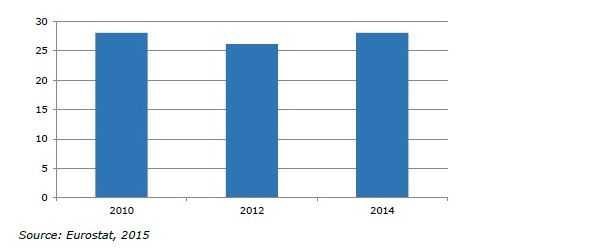
- Apparent consumption of sesame seeds in Germany amounted to 28,000 tonnes in 2014. In the period 2010-2014, German apparent consumption of sesame seeds remained stable, despite a slight decrease between 2010 and 2012.
- Germany's main consuming industries are the bakery and confectionary industries.
Market trends
Popularity of ethnic and Mediterranean cuisine in Germany
- Sesame seeds are often used in ethnic and Mediterranean cuisines for their flavour, aroma and high nutritional value. They can be used in spreads such us tahini and humus, for cooking as an oil, in sushi or as a topping for salads and cooked dishes.
- With a significant percentage of the population supporting the consumption of ethnic and Mediterranean dishes and the expansion of ethnic restaurants in the German market, sesame seeds have become extremely popular.
Make sure your product characteristics and quality match your target market and end-user in:
- Taste and odour
- Oil content
- Purity level & uniformity
- Hulled/natural
Keep different types of sesame seeds separate, e.g. do not mix seeds from different origins.
The large bakery industry in Germany
- The main use of sesame seeds in the German food industry is in baking products. In particular, sesame can be used as an ingredient in bread, snacks and crackers.
- In Germany, sesame seeds are extensively used in many different bread types or as toppings on several snacks (such as pretzels, which are very popular), or pastries.
- Germany has a large bakery and confectionery sector. In 2014, these two sectors accounted for nearly 20% of total Food and Beverage Industry production (BVE, 2015).
- According to the Federal Association of the German Food Industry, the baked goods market is expected to have an average annual growth of 1.6% up to 2017. In 2013, the industry generated sales of 13.2 billion and produced 6.6 million tons of bread (2012 figures) (GTAI 2014/2015). All the above indicates that the demand for sesame seeds will increase
SESAME SEED IN NETHERLANDS
Introduction
The Netherlands is a key trader in Europe, being the largest re-exporter of sesame seeds in the region. In the Netherlands, sesame seeds are mainly applied as ingredients in bakery products and salads, and are also increasingly used in ethnic cuisines and vegetarian & vegan diets. Opportunities can also be found in the organic market for sesame seeds; representing a niche, it is a market with growth potential in the Netherlands.
Product definition
Sesame seeds (Sesamum indicum) are grown primarily for their oil content. In Europe, sesame seeds are primarily used for toppings on bakery products, e.g. bread, bagels, hamburger buns, and confectionery. Restaurants and natural food consumers purchase sesame seeds for use in ethnic dishes. Sesame seeds can also be used in snacks and crackers, often in the form of "sesame sticks". Sesame seeds are supplied by countries in Africa, Latin America and South Asia.
Trade and macro-economic statistics
Imports
Figure 1: Total imports of sesame seeds to the Netherlands, x 1,000 tonnes.
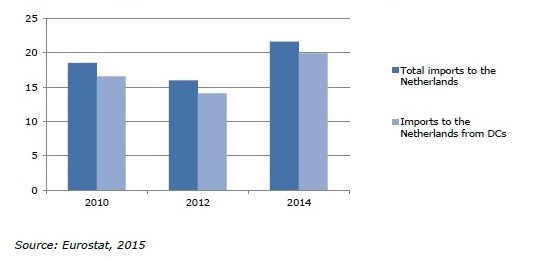
- In 2014, the total amount of sesame seeds imported into Europe amounted to 153,000 tonnes and around 306 million. The Netherlands accounted for 14% of total imports in volume and 13% in value.
- In 2014, the Netherlands imported 22,000 tonnes of sesame seeds, representing an average annual increase of +3.9% in volume and +16% in value since 2010.
- The Netherlands mainly sources sesame seeds directly in developing countries, which had a share of 92% (in volume) of total Dutch imports in 2014. More specifically, of the 22,000 tonnes of sesame seeds imported by the Netherlands (around 40 million in value), 20,000 tonnes were sourced directly in developing countries (around 37 million in value).
Figure 2: Imports of sesame seeds to the Netherlands; the largest markets (in terms of 2014 volume) exporting sesame seeds to the Netherlands, 2010-2014 in 1,000 tonnes
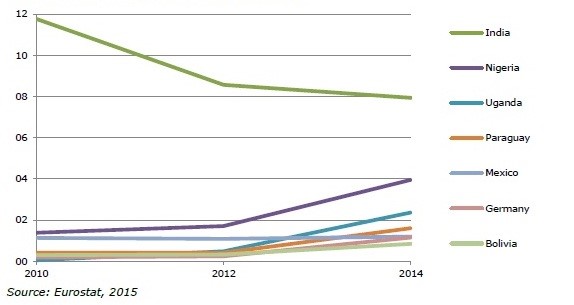
- The largest developing country supplier of sesame seeds to the Netherlands is India (37%), followed by Nigeria (18%) and Uganda (11%). Smaller but significant exporters to the Dutch market are Paraguay (7.5%), Mexico (5.6%) and Bolivia (4.0%).
- In 2014, Indian exports of sesame seeds to the Netherlands amounted to 8,000 tonnes in volume and around 15 million in value. In the same year, Nigeria supplied 4,000 tonnes (7.0 million) of sesame seeds to the Netherlands, while Uganda supplied 2,400 tonnes (3.0 million).
- Among the larger developing country exporters of sesame seeds, Uganda is the country which has increased its exports to the Netherlands most significantly, by +156% in volume and +171% in value, since 2010.
- Nigeria, Paraguay and Bolivia also recorded significant growth of sesame seed exports to the Netherlands. Nigeria increased its exports at an average annual rate of +30% in volume and +50% in value, while this was +40% and +55% for Paraguay and +30% and +50% for Bolivia since 2010.
- India reported a decrease of +9.4% in volume, but a slight increase in value (+1.9%). This indicates that the decline in India's sesame production has affected its share of the Dutch market, thus opening up opportunities for emerging suppliers in other countries. Production of sesame in India is declining in the long run due to the increasing pressure on land and a rising middle class (i.e. fewer individuals engaged in primary production). A general shift in sesame production from India (and China) to Africa is being witnessed in the international market.